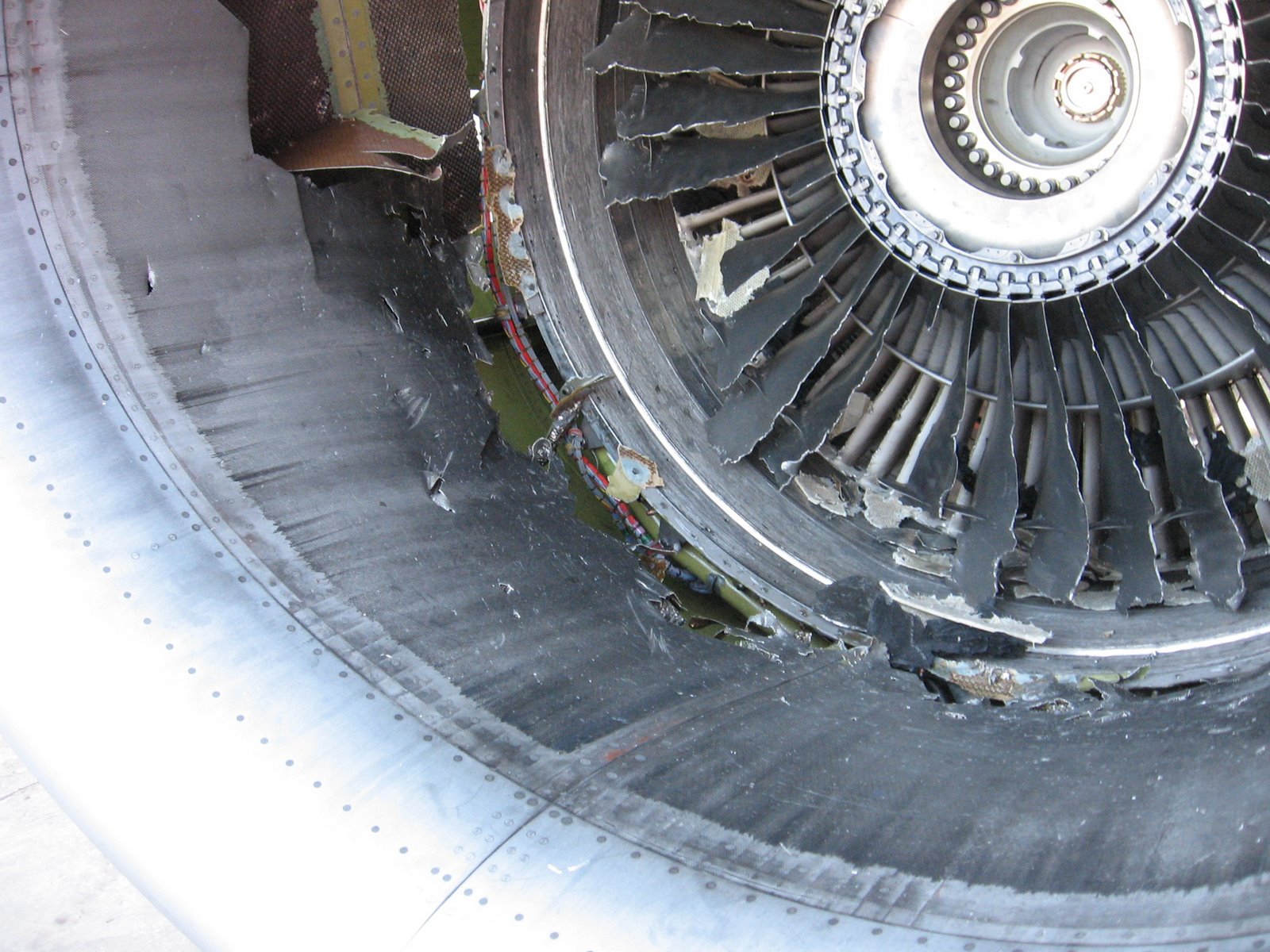I do believe you are correct. The bypass fan (the front blades you see) and LP compressor disk didn't fail. The inlet cowling failed (I retract what I said earlier about compressor disk failure). Possibly compressor surge? Some parts left with a lot of velocity to strike the fuselage. There are other photos showing damage to the left rear horizontal stabilizer and left winglet, too.
NTSB Identification: ENG08IA002On November 17, 2007, a Southwest Airlines' Boeing 737-300, registration number N676SW, flight number 438, experienced a failure of the No. 2 engine, a CFM CFM56-3B1 while climbing through FL250 to FL330. The flight crew reported feeling severe vibration, pulled both throttles back to idle, declared an emergency, and started an air turn back to Love Field (DAL), Dallas, TX. While heading back to DAL, the pilot reported seeing the following cockpit warnings: a No. 2 constant speed drive (CSD) low oil pressure, No. 2 engine low oil pressure, No. 2 generator bus OFF, No. 2 pack trip OFF lights, and No. 2 engine vibration meter at 5 units. The pilot also reported that while heading back to DAL, the start lever on the No. 2 engine was CLOSED. An uneventful single engine landing was performed and no injuries were reported to any of the occupants. The incident flight was an IFR flight conducted under 14 CFR Part 121 from Dallas, Love Field, TX, to Little Rock (LIT), AR and was the third flight of the day for the aircraft. None of the 133 passengers and 5 on board were injured.
Examination of the airplane revealed impact marks along the fuselage from about 10 feet aft of the right-hand forward entry door to about 6 feet forward of the right-hand aft entry door and along almost the entire length of right wing leading edge. The right horizontal stabilizer also exhibited impact marks along almost the entire leading edge. None of airframe impact marks were punctures through the fuselage's pressure vessel.
Examination of the No. 2 engine revealed that all the fan blades exhibited heavy airfoil damage, all the fan blade roots remained installed in the disk, and several fan blades fractured near the platform. The forward and rear spinner cones were no longer attached to the fan disk and a large penetration hole was noted on the right-hand side of the fan cowl just forward of the engine fan case. No breaches of any of the engine cases or signs of fire damage were noted.
Metallurgical examination of the fracture surfaces of the fan blades and the fragments of the rear spinner aft flange at the Safety Board revealed no pre-existing fatigue type mechanism and all the fractures were consistent with overstress. Examination of all thirty-eight (38) fan blade spacers revealed no fretting marks on any of the front faces; however, four sequential spacers exhibited axial distortion of their lug in the forward direction. The engine manufacturer, CFM, concluded that a severe axial load rearward was applied to the spacers by the rear spinner cone prior to the spinner cone release and that the maximum force was localized where the distorted spacers were located.
Based on the lack of evidence for a pre-existing fatigue type fan blade or rear spinner fractures, and the physical evidence suggesting a possible single hard impact to the rear spinner as the initiating event causing the engine failure, possible external sources of foreign object ingestion were examined. A visual and fluorescent black light inspection was performed on all the fan blades, the fan inlet case, and the basic fan frame structure while the engine was still installed on the airplane, and the fan blades were again examined at the CFM Investigation Laboratory after they were removed from the fan disk. No bird remains or evidence of a bird ingestion event were found.
The Boeing 737 has had prior events where water leaking from the forward lavatory was suspected to have turned into ice during flight. This ice would depart from the airplane's forward service panel and be ingested into the No. 2 engine resulting in an in-flight shutdown of the No. 2 engine. Airworthiness Directives (AD) were issued to address the source of the leaks and to require periodic inspections to detect potential leaks. Review of Southwest Airlines' maintenance records for airplane N676SW revealed that the airplane had been modified and was inspected in accordance with the AD requirements. Examination of the maintenance write-ups prior to the No. 2 engine failure and after the airplane was returned to service showed no history or problems related to a leaky forward lavatory. Examination of the forward lavatory panel and the airplane skin in the vicinity of the forward lavatory panel revealed no signs of fluid streaks or leaks. Furthermore, the fan blades were subjected to an energy dispersive spectroscopy (EDS) analysis to document material transferred and deposited onto the fan blades. No unrecognizable material was found and all the material identified was consistent with material coming from either the inlet cowl or the spinner cone.
The characteristics of the damage in 2007 are very different from the current incident.
Speaking of FOD (foreign object debris), you don't want to get objects too close to the inlet with the engines running. They gulp a LOT of air...


